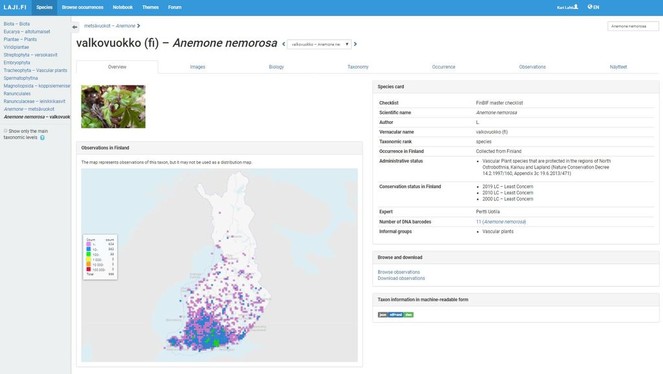|
Biodiversity Information Science and Standards : Conference Abstract
|
|
Corresponding author: Kari M Lahti (kari.lahti@helsinki.fi), Liselott Sjodin Skarp (liselott.sjodin.skarp@slu.se)
Received: 15 Jul 2019 | Published: 17 Jul 2019
© 2019 Kari Lahti, Liselott Skarp
This is an open access article distributed under the terms of the Creative Commons Attribution License (CC BY 4.0), which permits unrestricted use, distribution, and reproduction in any medium, provided the original author and source are credited.
Citation: Lahti KM, Skarp LS (2019) Finnish Biodiversity Information Facility - Improving the Taxonomic Coverage and Deepening the Information Content Through Collaboration. Biodiversity Information Science and Standards 3: e38274. https://doi.org/10.3897/biss.3.38274
|
|
Abstract
The Finnish Biodiversity Information Facility FinBIF (LINK: species.fi), operational since late 2016, is one of the more recent examples of comprehensive, all-inclusive national biodiversity research infrastructures. FinBIF integrates a wide array of biodiversity information approaches under the same umbrella. These include species information Fig.
To improve the taxonomic coverage and the content of species information, FinBIF is starting a process to collaborate with the species information community at large, in order to collate already existing but not yet openly distributed information. This also means digitisation of information from analogue sources. In addition, the attempt is to join forces with Scandinavian counterparts, namely Artdatabanken (LINK: https://www.artdatabanken.se/) and Artsdatabanken (LINK: https://www.artsdatabanken.no/), for more efficient knowledge exchange within the countries sharing the same biogeographical region and thus similar species composition. The aim is also to reach politically high level agreement for deeper and wider commitment to collaborate in compiling, digitising and sharing relevant biodiversity information over the national borders.
Keywords
biodiversity informatics, species information, taxonomy
Presenting author
Kari Lahti
Presented at
Biodiversity_Next 2019
Funding program
Finnish Research Infrastructures FIRI
